In my last post, I discussed the BBS and how it worked. (It would be helpful to review, to understand the terminology.) In this post, I have resurrected, in part, the BBS I used to run from 1988-1990. It was called “The Tower”, for no particularly good reason except that it sounded cool to my teenage mind.
Now, bringing this back to life was no simple task, but was aided by some foresight I had 20 years ago. I had a Mac with a disk drive, and realizing the floppy era was coming to a close, I decided to produce disk images of all the 3.5 inch floppies I had saved from my Apple II days. Fortunately, my last Apple II, the IIGS, used 3.5″ drives instead of the 5.25″ that were more common on the Apple IIs. The Macs that had floppy drives all had 3.5″ drives. Additionally, Apple had included software to on the pre OSX MacOS to read ProDOS (Apple II) disks. Thus, in the year 2000, I could mount an Apple II floppy from a dozen years prior and make an image out of it.
I did not have a full working version of my GBBS, however, so I had to download a copy. I also had to do a lot of work to bring it up to Macos (not MacOS, but Macos, Modified ACOS), which was a modified form of the GBBS compiler I used at the time. All of my source files required Macos and not the stock GBBS software. Believe me, even though I ran the BBS for a couple years and wrote a lot of the code, remembering how to do any of this after 30 years was non-trivial.
Rather than hook up my old IIGS, which I still have, it made a lot more sense to use an emulator. (It also enabled me to take screen shots.) I used an emulator called Sweet16, which is a bit bare bones but does the trick. In case you’re not familiar with the Apple II series, the early models were primarily text-driven. They had graphics, of course, but they were not GUI machines. After the Mac came out, there was a push to incorporate a GUI into the Apple II and the result was the Apple IIGS (Graphics and Sound). While it had a GUI-driven OS (ProDOS 16 at first, replaced by GS/OS), it was backwards compatible with the old Apple II software. The GBBS software I ran was classic Apple II, and thus it was a bit of a waste to run it on an Apple IIGS, but, well, that’s what I did.
In this screen shot (Figure 1), you can see the Apple IIGS finder from which I’m launching the BBS software, the only GUI shot you’ll see in the article:
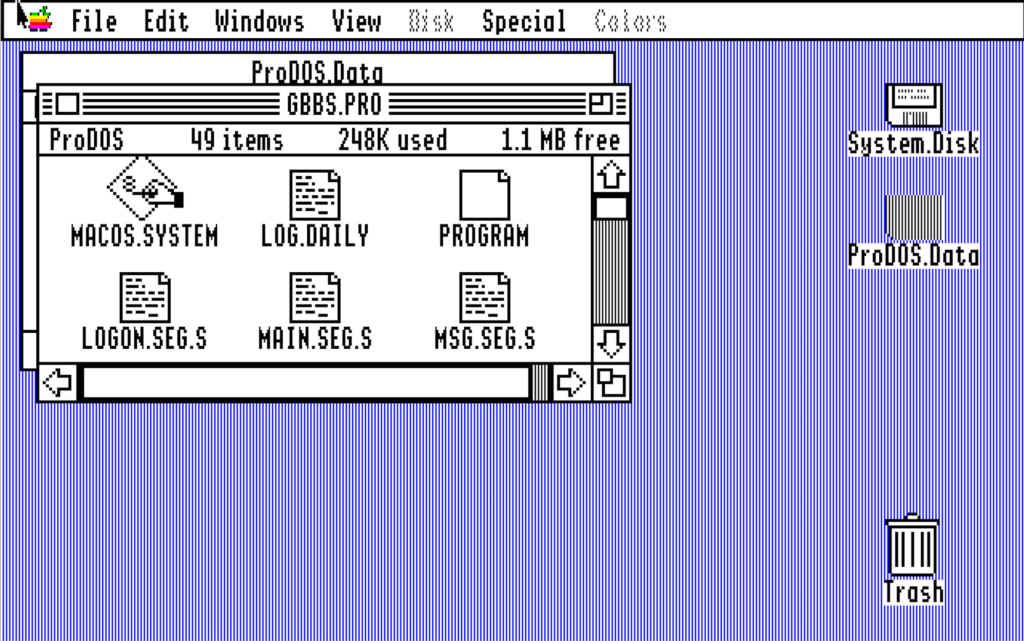
The next shot (Figure 2) shows the screen only visible to the sysop, while waiting for a call. As sysop, I had the option to hit a key and log in myself, but if a user dialed in the system would beep and the user would begin the log in process. I’m not sure why we’re awaiting call 2 which will be call 1 today, but it looks like a bug I need to hunt down. The screen helpfully tells me if new users have signed up for the BBS, and whether I have mail.
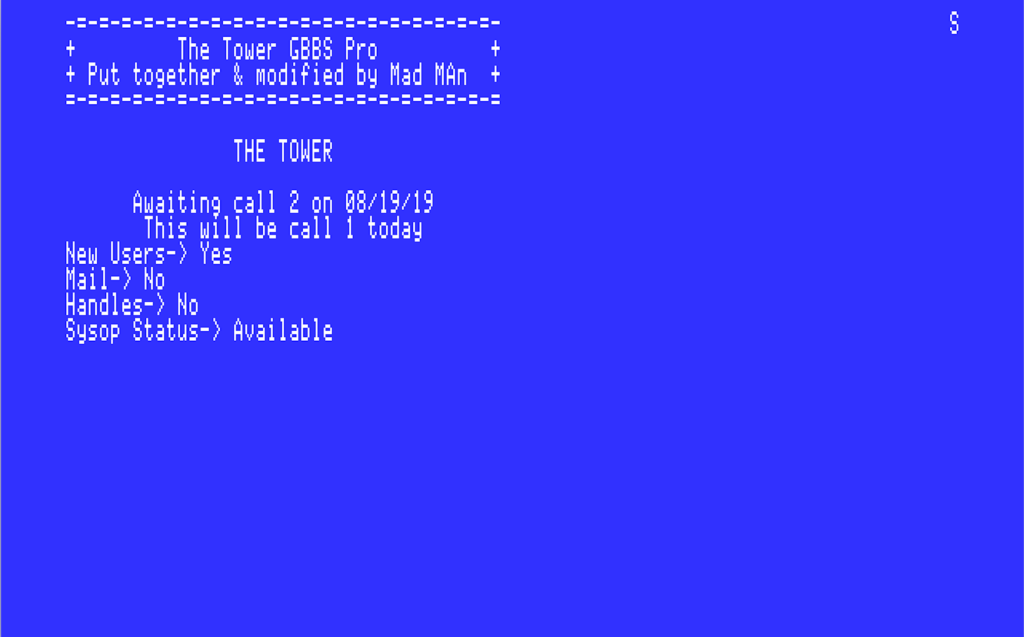
(If you want to know why I used the silly handle “Mad MAn”, please see the previous article.)
The next screen shows the BBS right after logon. The inverse text block at the top was a local sysop-only view, showing user information including the user name and phone number, as well as the user’s flags. These are interesting. Some BBS software provided access levels for controlling what a user could and could not do. Instead of sequential access levels, GBBS provided a series of binary flags the sysop could set. Thus, I could give access to one area but not another, whereas the sequential access levels mean that each access level inherits the privileges of the previous level. Very clever. A few other stats are displayed that I won’t go into. I’ll turn off the sysop bar for the remaining screen shots.
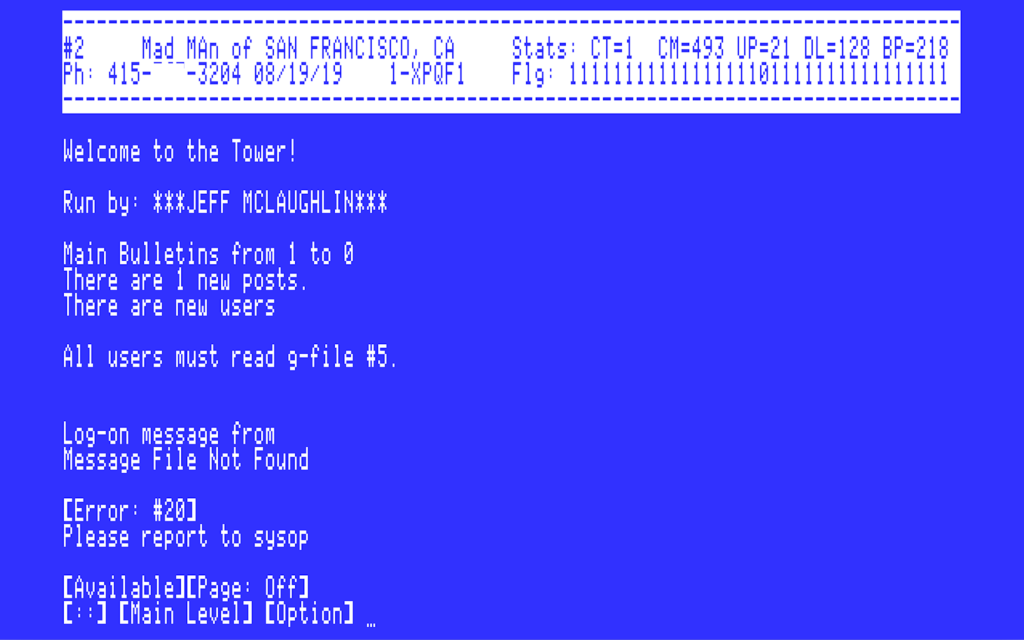
Note the prompt provided to the user in figure 3. It tells you:
- That the sysop is available
- That the user has not paged the sysop
- The double colons (::) normally would display time left on the system. Since this was a dial-up system, I needed to limit the time users could spend on the BBS. But as sysop, I of course had unlimited time.
- The BBS had different areas and the prompt (like an IOS prompt) tells you where you are (“Main level”)
Next, in figure 4 you can see the main menu options for a user logged into the BBS. This is the default/stock GBBS menu, as my original is lost. Despite the limited options, this was like entering a new world in the days of 64K RAM. You can see that a user could send/read mail, go to a file transfer section, chat (or attempt to chat) with the system operator, or read the public message boards.
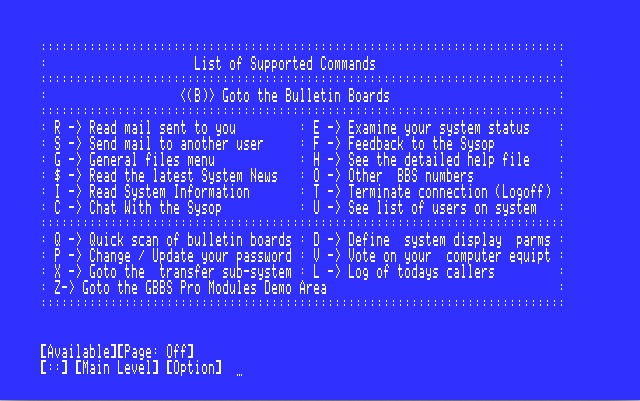
Next, the user list. I had 150 users on my BBS, not all of them active. I blacked out the last names and phone numbers, but you can get a sense of the handles that were used at the time. In addition to these names, there were a lot of Frodo’s and Gandalf’s floating around. Also note that most BBSing was local (to avoid long-distance charges.) Sadly, none of these users has logged on since 1989. I wish they’d come back. Oggman, whom I mentioned in my last post, was a user on my board.
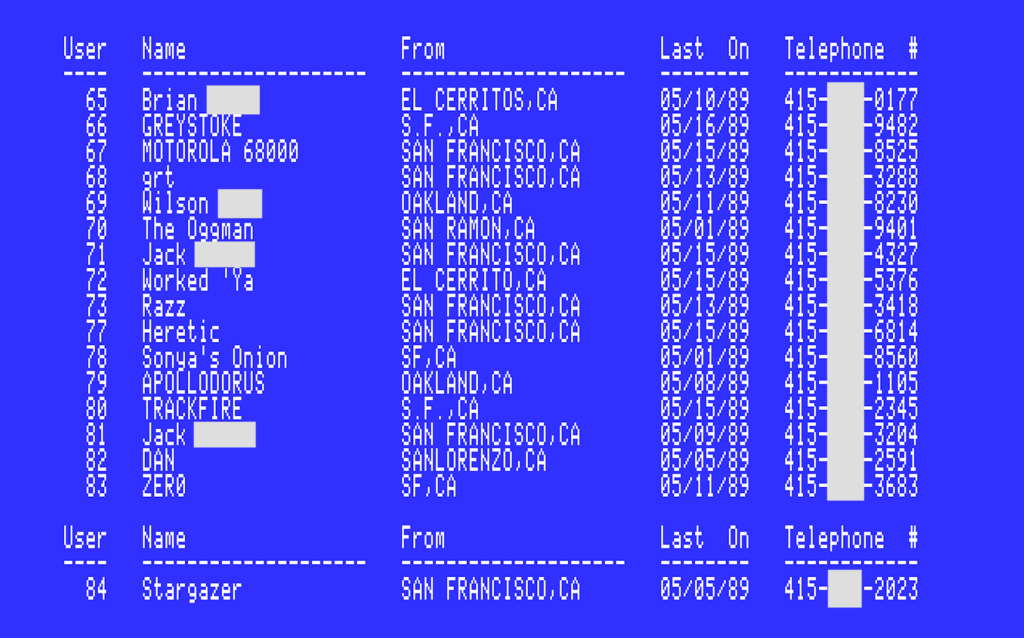
Conclusions
I recently interviewed a recent college grad who asked me how she could be successful at a company like Cisco. My answer was that you have to understand where we came from in order to understand where we are. You cannot understand, say, SD-WAN without understanding how we used to build WANs. Go back to the beginning. Learn what SneakerNet was. Understand why we are where we are. Even before SneakerNet, some of us were figuring out how to get computers to talk to each other over an already existing network–the analog telephone network. As a side note, I love vintage computing. It’s a lot of fun using emulators to resurrect the past, and I hope to do some physical restorations some day. Trying to figure out how to boot up a long-defunct system like this BBS provides a great reminder of how easy we have it now.
5
4.5
My god, I feel old. I had an Apple ][+ for years, and how cool the ][GS seemed in comparison when I bought one. Then I got a 1200 baud modem, and the very slow online world was revealed (good thing it was mostly text-based). Then I bought a used US Robotics 9600 baud modem, which seemed blazingly fast in comparison.
I remember being on the Apple 2 BBSs, and the Mac ones that followed (when I got a Mac I joined BMUG). But I’ve forgotten so much of that world. The name “The Tower” sounds awfully familiar, but I could be kidding myself.
Thanks for stopping by. I always wanted that USR 9600 modem but I couldn’t afford it. Being stuck at 2400 baud was a killer for my BBS…at least until the real killer of crashed hard drives. You probably wouldn’t have been on my BBS unless you were in the San Francisco Bay Area, and then I would only recognize you by your handle. But I did find that there were a number of “towers” out there and it was not so original a name. I came up with the name when I was fishing on my grandfather’s charter boat one weekend and I heard the deck hands chatting on the radio. One of them mentioned “Tower of Power”, the band, and I loved the sound of it. I figured it would be better to shorten it.
From what I remember, the BBS I knew was just “The Tower,” though that’s certainly not definitive. Back then I’d call around after 11 PM, when phone rates were cheaper (and back when I stayed awake that late).
I just had a sudden flash of my handle back then: Monte. This is one of those times when you remember something only when you’re not trying to do so. I’m fairly sure that’s it, or close to it, but I don’t have anything left from that age to verify.
… to clarify: I started calling around my area after 9, and more widely after 11, not that I called whichever Tower it was specifically at that time.